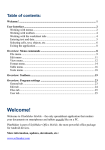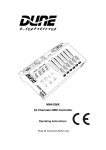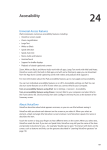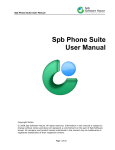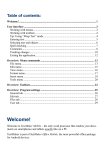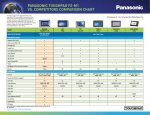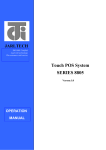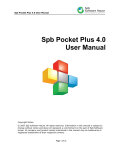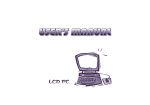Download Quick Start Guide
Transcript
Top Side BM Left Side ! @ # $ % ^ Z & * ( BL BN BO BP BQ BR BS BT BT BU CL CM CN CP CQ CR CS CT CO Quick Start Guide Sahara Slate PC® i400 Series Tablet PCs 1. 2. 3. 4. 5-6. 7. 8. 9. 10. Left Side VGA Out Ethernet Port (RJ45) Modem Port (RJ11) Firewire 400 (6-pin) USB 2.0 eSATA Headphone Jack Audio In Jack Stylus Pen Holder 11. 12. 13. 14. 15. Top Side PCMCIA Slot Power Switch Bluetooth Switch WiFi Switch DC In (Power In) 16. 17. 18. 19. 20. 21. 22. 23. 24. 24. 25-27. 28. Front Battery LED Hard Drive Activity LED Speaker SAS Button Screen Rotation Button Volume Up Button Volume Down Button Microphone Array Screen Mode Toggle (i440D) Programmable (i412/i440T) Programmable Buttons Fingerprint Reader Congratulations on your purchase of a Sahara Slate PC® i400 series Tablet PC. Your dual mode touch screen/active digitizer i440D or touch screen i412T/i440T Tablet PC was designed to allow you to be up and running as quickly as possible. For more information regarding setting up and using your Sahara Slate PC, please consult the included User’s Guide or visit our website at www.tabletkiosk.com. What’s in the Box Your Sahara Slate PC should come securely packaged in its shipping container along with the items listed below. Contact your dealer immediately if you find that anything is missing or damaged. Note, however, that contents may be changed without notice. 1. 2. 3. 4. 5. 6. 7. 8. 9. AC Adapter with Power Cord Ultrafiber Cleaning Cloth Neoprene Slip Case Simple Stand Operating System Quick Start Guide (excludes openSUSE Linux) System Restore Disc(s) User’s Guide and this Quick Start Guide Standard Lithium-Ion Battery Pack Stylus Pen Setting Up Your Sahara Slate PC Please read the following steps to help you begin using your new Sahara Slate PC i400 series Tablet PC as quickly and easily as possible. Step 1: Insert the Battery Pack Turn the tablet over and place it, screen down on a solid, clean, flat surface. CAUTION: When turning over the Sahara Slate PC, be careful not to place it on a surface that could scratch or damage the screen. You can place the included slip case on the surface before carefully setting the computer down to protect the screen. Align the battery into the battery compartment and then slide it into the computer until it clicks securely into place. Slide the battery-locking tab (the tab closest to the top of the tablet) in the opposite direction of the unlocking arrow engraved on the tab itself. Once the locking tab clicks into position, the battery should be securely seated. Step 2: Connect the Sahara Slate PC to an External Power Source Locate the AC adapter and the power cord. Plug the power cord securely into the AC adapter. Plug the AC adapter’s connection cable into the “DC In” port on the top side of the Sahara Slate PC. Once the adapter plug is securely in place, plug the power cord into an external power socket. IMPORTANT: You should allow the battery to charge fully before disconnecting the Sahara Slate PC and running it on battery power for the first time. NOTE: When you first connect the Sahara Slate PC into an external power source, the battery charge indicator will begin to glow amber. When the battery is fully charged the indicator will turn green. See the section in the User’s Guide entitled Battery Care for tips on maximizing battery life and performance. Step 3: Connect Applicable Peripherals and Networking Cables If you would like to use any external peripherals with the tablet (i.e. USB mouse, USB keyboard, etc.), or are planning to connect to the Internet and/or a corporate LAN using a wired connection (RJ45) as opposed to wirelessly, connect them now. IMPORTANT: When you power on the tablet for the first time, you will need to have an external USB keyboard connected in order to complete the Windows XP Professional or Windows 7 Professional welcome screens on the i412T/i440T. An external USB keyboard is not required for Windows XP Tablet PC Edition or Windows 7 Professional welcome screens on the i440D as you can use the on-screen keyboard. Step 4: Power on the Sahara Slate PC Locate the three power switches on the top on the tablet. The switch (closest to the PCMCIA expansion slot) is the computer’s main power toggle. Slide it away from the PCMCIA slot and hold it there until it emits a blue glow (about 1-2 seconds) and then release it. The Sahara Slate PC will now boot up. Step 5: Complete the Operating System Installation When your system powers on for the first time, you will be prompted to enter your product key to complete set-up (Windows 7 only). The key can be found on the C.O.A. sticker located on the back of the system. Windows (all versions) will then have a few questions for you to answer in order to localize and finish your installation. Refer to your operating system’s manual for information on any of the questions you are unsure how to answer. When done, you will be taken to the Windows desktop (Windows 7 will continue optimizing and updating your system and may restart). Step 6: Using the Stylus Pen Unlike a standard laptop or desktop PC, navigating the operating system’s user interface on a Tablet PC is performed using the stylus pen, or even your fingers (if you have an i412T/i440T or your i440D’s screen in touch screen mode). Touch Screen: Navigating with a touch screen is different from navigating with a mouse. Hold the stylus pen as if you were writing with a standard pen. Instead of sliding the pen around the screen, just tap on what you want to interact with. Sliding the pen while lightly touching the tip to the screen will move the on-screen pointer around as if you were using a mouse and holding down the left mouse button. In other words, you would be performing what is known as a drag operation. Also, remember that since the screen is sensitive to the touch, resting your hand on the screen while using the pen might make the pointer react unpredictably. Active Digitizer (i440D only): In this mode, the pen doesn’t even need to touch the screen to activate and move the pointer. Hold the stylus pen as if you were writing with a standard pen. Place the tip of the stylus just above the screen and move it around. The pointer should follow the tip of the pen. In this mode your hand may rest on the screen, since this will not affect the behavior of the pointer. TIP: When trying to select or activate something on the screen—in either mode—with the stylus pen, pay attention to the position of the pointer icon on the screen instead of the tip of the pen. When using a touch screen, the icon will be the standard arrow pointer. In digitizer mode the pointer icon is a diamond shaped target. With both a touch screen and an active digitizer, tapping lightly on the screen will perform a standard left mouse button click. Tapping twice in rapid succession will perform a doubleclick. Holding the tip of the pen against the screen without moving it for about a second or so will perform a standard right mouse button click. Inputting Data: You can use the Tablet PC Input Panels in Windows 7 and Windows XP Tablet PC Edition to enter information via the On-Screen Keyboard, Character Pad or Writing Pad. You’ll find the edge of the Tablet PC Input Panel docked on the left-hand side of your screen. When in digitizer mode, hovering the pointer over the panel will cause it to slide outward a bit making it easier to access. Tap on it once to activate the panel and slide it to the center of your desktop. When finished, tap the “close” icon in the upper right corner of the panel to re-dock it. When using a touch screen, tap once on the input panel’s edge to slide it to the center of your desktop. In Windows 7 you can also enable the PC Input Panel Toolbar on the Windows Taskbar. For more information about using the input panels, see the Windows Quick Start guide that came with your Sahara Slate PC or check out the Tablet PC Tutorials in Windows. i440D NOTE: When in active digitizer mode, animated cues, or floating tips, will appear when performing a right-click operation or when text input is required in tablet aware applications. Another option for inputting data is the Eyesboard™ Virtual Keyboard application included with all Sahara Slate PC i400 series Tablet PCs (may not be included on systems with Windows 7). This resizable, on-screen virtual keyboard will allow you to type on the screen as you would with a standard laptop keyboard. Just double-tap on the application’s short-cut icon located on the desktop to begin using it. You can access the Eyesboard user’s manual by tapping on the “?” button in the upper right hand corner of the keyboard. Remember to put your i440D into touch screen mode unless you are planning to type with the stylus. NOTE: If your system came with Windows XP Tablet PC Edition, you may have to install the Eyesboard Virtual Keyboard application before you can use it. To install, first double-tap on the .NET Framework installer located on the desktop to install the .NET Framework. Once installed, double-tap on the Eyeboard installer icon on the desktop to install the Eyesboard application. Calibrating the Touch Screen If you find, while using your Sahara Slate PC (in touch screen mode on the i440D), that the position of the pointer arrow isn’t matching the touch of the stylus, you should calibrate the touch screen. 1. 2. 3. Locate the Shortcut icon to the TouchSet Utility on your desktop and double-tap it to launch the TouchSet Utility application. Tap on the “Calibration” tab. The default “4-Point” calibration should be sufficient in most instances for creating an accurate calibration setting. Tap on the “Calibrate” button to begin the calibration routine. Tap on the center point in each of the red crosses that appear. When finished, you’ll be returned to the TouchSet Utility Calibration panel. NOTE: If you find that you cannot drag elements around the screen, or you cannot write in the input panels, your touch screen is most likely set to “Point” mode. In the TouchSet Utility, tap on the “Configuration” tab to get to the “Operation Mode” selector. Tap on the “Stream Mode” option and then tap the “Apply” button. Calibrating the Digitizer (i400D only) If you find, while using your Sahara Slate PC in digitizer mode, that the position of the pointer arrow isn’t following the tip of the stylus, you should calibrate the digitizer. In Windows 7: 1. In the START Menu, tap on “Control Panel” and then in the window that opens, tap on the “Hardware and Sound” category. 2. From the “Hardware and Sound” window, find the “Tablet PC Settings” category and tap on the sub-category “Calibrate the screen for pen or touch input”. 3. On the “Display” tab is a “Calibrate...” button. Tap the “Calibrate...” button to begin the calibration routine. 4. Follow the on-screen instructions to complete the calibration. The routine is very similar to the touch screen calibration. Tap in the center of the crosses when they appear on the screen. In Windows XP Tablet PC Edition: 1. In the START Menu, tap on “Control Panel” and then in the window that opens, tap on the “Printers and Other Hardware” category. 2. From the “Printers and Other Hardware” window, look under “or pick a Control Panel icon” for “Tablet and Pen Settings” and tap to open the panel. 3. On the “Settings” tab is a “Calibration” section. There is a drop down that will allow you to calibrate both landscape and portrait orientations for improved accuracy. Choose the orientation you wish to calibrate and then tap the “Calibrate...” button to begin the calibration routine. 4. Follow the on-screen instructions to complete the calibration. The routine is very similar to the touch screen calibration. Tap in the center of the crosses when they appear on the screen. Connecting to a Wireless Network 1. 2. 3. 4. Turn on the WiFi transmitter using the toggle switch on the top of your tablet. In the Windows 7 System Tray, tap on the “Wireless Networks” icon. In the Windows XP START Menu, tap on “Programs > Intel PROSet Wireless > Intel PROSet Wireless”. From the list that appears, tap to select the network you wish to connect to and then tap the “Connect” button. If no wireless networks appear after a few moments, tap on the refresh button located on the right side of the dialog box. If the wireless network you are attempting to connect to is security-enabled, you will see a dialog box requesting a network key or password. The key/password (your network administrator should be able to supply this to you) must be entered correctly or you will not be able to successfully connect to the network. If you entered the network key correctly, you should now be connected to the wireless network. If it appears you are connected to the network, but have limited or no actual connectivity, it is most likely due to an improperly entered network key. Disconnect from the network by tapping the “Disconnect” button and try to connect again. If you continue to have trouble connecting, contact your network administrator for assistance. Connecting with a Wireless Bluetooth Device 1. Turn on the Bluetooth transmitter using the toggle switch on the top of your tablet. In Windows 7: 2. 3. 4. 5. 6. Double-tap on the Bluetooth Places icon on the desktop. Turn on the discovery service on your Bluetooth device. Double-tap on the “Search Devices” icon to start the Bluetooth Discovery Service on the tablet. Any devices found will appear in the window. Choose the device you want to use and double-tap on its icon to open a window that allows you to choose a service. Double-tap on the desired service to begin the pairing process. Enter a Bluetooth passkey if prompted. In Windows XP: 2. 3. 4. 5. 6. 7. 8. Double-tap on the BlueSoleil icon on the desktop to start the Bluetooth service. When the service has started, there will be a blue Bluetooth icon in the system tray. Double-tap on it or on the BlueSoleil icon on your desktop to start the BlueSoleil application. Turn on the discovery service on your Bluetooth device. Double-tap on the orange globe in the application’s window to start the Bluetooth Discovery Service on the tablet. When discovered, the Bluetooth device’s icon will appear orbiting the orange globe. Tapand-hold on the icon and choose “Pair Device” from the pop-up menu. Enter a Bluetooth passkey if prompted Once paired, tap on the appropriate Bluetooth service icon at the top of the screen to connect to the device. Only services that are lit can be chosen. Make sure that the entire process is completed while your Bluetooth device is still in Discovery mode or the pairing process will fail. If necessary, you can restart the Discovery process on your device and redo any incomplete steps. Restoring Your System Using the System Restore Disc What you will need before you begin: 1. A Windows 7 Professional, Windows XP Professional or Windows XP Tablet PC Edition System Restore DVD for the Sahara Slate PC i400 series Tablet PCs. 2. External USB DVD drive with its own power supply (not USB Bus powered) 3. USB keyboard, USB mouse and USB hub To Restore Your System: IMPORTANT: This process is destructive to the data stored on your hard drive. All existing data will be lost. It is vital you back-up any files on your hard drive to an external storage device or disk that you wish to keep before you proceed. Step 1: Set up the required hardware: Plug the USB mouse and keyboard into the USB hub and plug the hub into one of the available USB ports on the tablet. Plug the USB cable from the DVD drive into the remaining USB port of the tablet. Make sure that the i400 recovery DVD is in the USB DVD drive and that the drive has power and is on. To Restore Using the Windows 7 Restore Disc: Step 2: Booting the Sahara Slate PC to the Recovery Application 1. 2. Power up your i400 series Tablet PC. If your drive has an existing partition (overwriting existing OS): When prompted press any key to boot to the recovery DVD. If your drive doesn’t have an existing partition (new drive, no OS): It will automatically load the recovery application. 3. Select the “Tools” Button and then the “Reset Partition” Button to continue. 4. Enter the partition size you wish to create for your OS. In general, you should use the number from the “Free Space” box as this will provide you with the largest system partition possible. 5. Select the File System desired: FAT32 or NTFS (recommended). Click “Next” to continue. 6. Select “OK” to proceed with partition creation. 7. Select “OK” if you understand that this process will PERMANENTLY DELETE ALL OF THE EXISTING DATA ON THE DRIVE. 8. Select “OK” once the drive has been partitioned and then “Cancel” to return to the main menu. 9. Select the “Restore Now!” Button. 10. Select “OK” to prepare the partition you created above, and then select “OK” again to restore the operating system. 11. Select “Quit” once the restore process completes to reboot your Sahara Slate PC. Immediately eject the DVD or unplug the USB DVD drive from your Sahara Slate PC so the system will reboot from the restored hard drive. To Restore Using the Windows XP Professional or Tablet PC Edition Restore Discs: Step 2: Partitioning the Hard Drive (required for a new Hard Drive only) If you are simply attempting to restore your Sahara Slate PC using the hard drive that came with your system, you can skip this step and proceed to Step 3. You will need to use the software that came with your new hard drive—or another third party program of your choosing that is designed to partition hard drives—in order to create a primary system partition to house the restored OS. At a minimum, any bootable disc containing Microsoft’s “FDISK.EXE” utility should be sufficient. Step 3: Booting the Sahara Slate PC to the Recovery Application 1. 2. 3. 4. 5. 6. Power up your i400 series Tablet PC. It will start from the DVD and automatically load the recovery application. Select “OK” to proceed with partition creation. Select “OK” if you understand that this process will PERMANENTLY DELETE ALL OF THE EXISTING DATA ON THE DRIVE. Select “Quit” once the restore process completes to reboot your Sahara Slate PC. Immediately eject the DVD or unplug the USB DVD drive from your Sahara Slate PC so the system will reboot from the restored hard drive. What To Do After Successfully Restoring Your System: After your system successfully boots in your newly restored operating system, you will have to copy back any of your data that you backed up before attempting the restore procedure. You will also have to reinstall any applications you had installed yourself after receiving your Sahara Slate PC. Before you begin either of these tasks, we suggest going to “Windows Update” and installing any updates it finds that are labeled “Critical” or “Important”. 2832 Columbia Street, Torrance, CA 90503 310.782.1201 tel 310.782.1205 fax www.tabletkiosk.com ©2009 Sand Dune Ventures, Inc. All Rights Reserved. Sahara Slate PC and TabletKiosk are registered trademarks of Sand Dune Ventures, Inc. in the United States and other countries. Windows, the Windows logo, Windows XP and Windows 7 are registered trademarks or trademarks of Microsoft Corporation in the United States and other countries. rev 12.16.09










